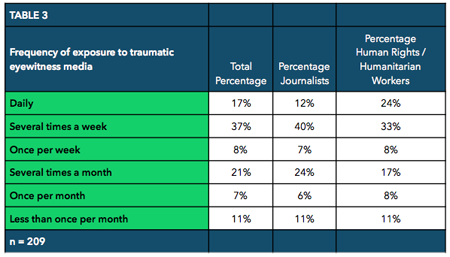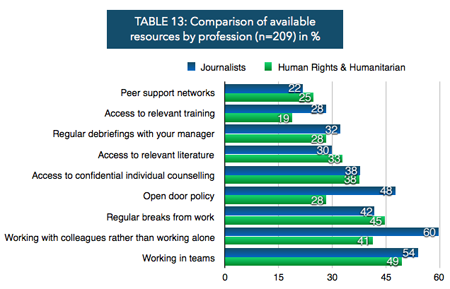Analysing eyewitness media has become an important part of the job in online journalism over the past few years, but understanding and managing the impact graphic user-generated content (UGC) can have on reporters is still an ongoing process.
Some 52 per cent of journalists surveyed by the Eyewitness Media Hub said they were exposed to traumatic UGC several times a week, with 12 per cent of them seeing traumatic material daily.
The research, launched in London on Thursday, highlighted the emergence of a “digital frontline” in the newsroom.
“The frontline is extended,” said Sam Dubberley, co-founder of the Eyewitness Media Hub, who was part of the research team behind the report.
“You don’t choose to be on the frontline, but you are on the frontline and you’re seeing so much more.”
The study surveyed 209 journalists and human rights professionals who work with eyewitness media. The team also conducted in-depth interviews with 38 respondents to gather insights about the risk of vicarious trauma in newsrooms and the support available to those who view traumatic UGC.
Two interviewees who have worked both in the field and on the “digital frontline” told the research team there is a higher chance of seeing traumatic imagery when dealing with user-generated content in the newsroom.

Screenshot from Eyewitness Media Hub.
“You witness it a lot more with UGC,” one senior editor said during the interview. “You’re exposed to more intense visual material than battle hardened war cameramen sitting in Sarajevo in the middle of the 1990s, because it’s coming at you from everywhere.”
The frequency of exposure and whether a journalist expected to see traumatic eyewitness media were two factors that influenced the impact the footage had on the viewer, according to the study.
The sounds accompanying the user-generated content and having a personal connection to the area the footage or image originated from were also identified as influential factors.
The research also showed newsroom managers acknowledge vicarious trauma as an issue, but have yet to find ways to deal with the problem.
Some best practices were highlighted by the report, such as rotating social media producers between hard news and soft news to allow for breaks, or checking in with staff exposed to such footage regularly and making counselling resources available.
When asked to identify the resources or processes that would help, journalists who work with UGC highlighted the importance of taking breaks and having access to training, as well as positive reinforcement from a manager or editor and having peer support networks in place.
But “three of the top four resources professionals say are the most useful are the least available,” said Dubberley.

Screenshot from Eyewitness Media Hub.
Just as hostile environment training is provided to journalists working in the field, so should guidance and best practices for working with graphic user-generated content be made available to those on the "digital frontline".
Gavin Rees, director of Dart Centre Europe, said at the launch: "We're in the distress business. The question is how much we own it and manage it."
You can read the full report and the team’s recommendations here.
Free daily newsletter
If you like our news and feature articles, you can sign up to receive our free daily (Mon-Fri) email newsletter (mobile friendly).
Related articles
- Digital journalism expert Alastair Reid on TikTok, AI and burnout
- Vicarious trauma: considerations for news leaders
- Seven tips for publishers to get started with TikTok
- Kevin Donnellan, social media consultant, on the dos and don'ts of social media reporting
- Hazel Baker, head of UGC newsgathering at Reuters, on deepfakes, misinformation and verification









